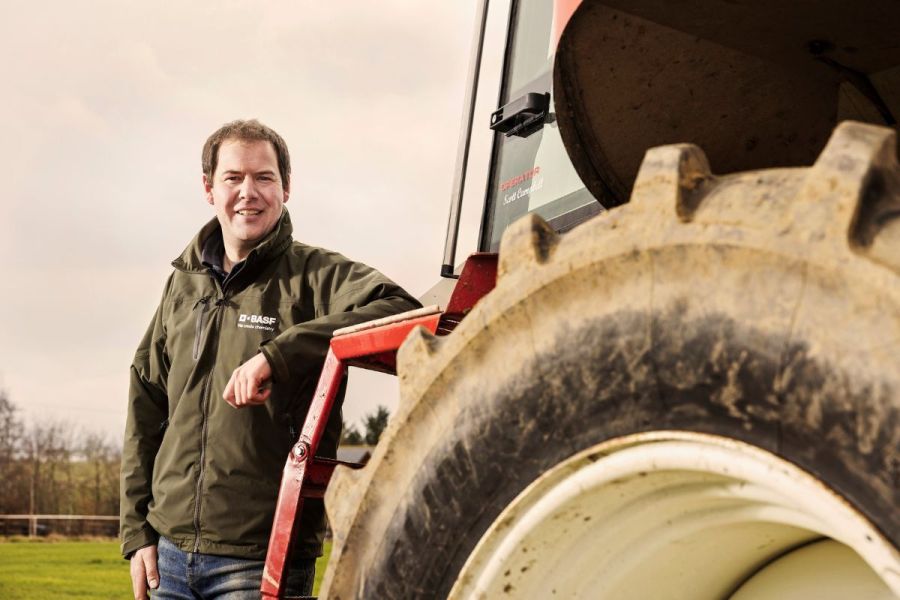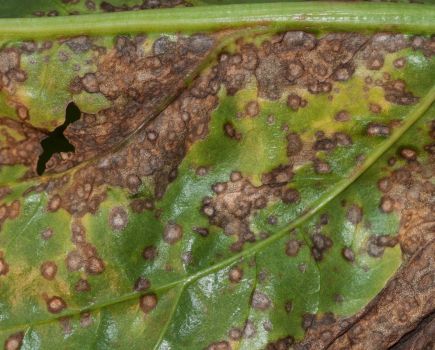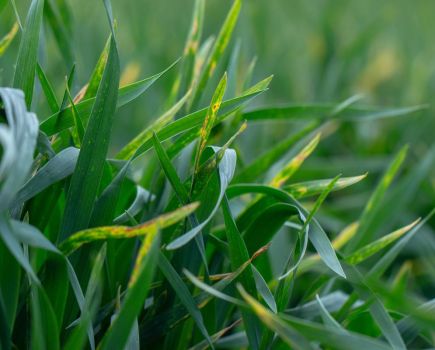Repercussions from the war in Ukraine are changing plans on a Scottish farm. CPM joins Scott Campbell to discuss the future cropping and agronomy at his Aberdeenshire farm.
“My concern is harvest 2023.”
By Mike Abram
Scott Campbell never once utters the name Vladimir Putin during our conversation, but it’s clear his decision to invade Ukraine is likely to have big implications for Scott’s farm over the next few years.
Take the Agri-Environment Climate Scheme (AECS), for example, which is the Scottish version of Countryside Stewardship. Before the war in Ukraine it was highly likely Scott would enter his 415ha Aberdeenshire farm – which he farms in partnership with his father, Iain and uncle, Neil – into the scheme by the end of April deadline. Now, he’s not so sure.
“It’s a hard decision – one part of me is saying I should, and the other that I shouldn’t.”
The impact on world grain supplies off the back of war in a country often dubbed as the breadbasket of Europe is the obvious reason behind his reticence. Others are worried too. The EU Commission was due to consider a proposal in late March to allow cultivations on ‘set-aside’ land to boost production in 2022, while there were reports in Ireland that farmers might be asked to grow more grain crops.
“We have benefitted our soils by applying farmyard manures and growing green manure crops, so I’m thinking we should grow maximum cereals for the next four or five years without entering a scheme,” says Scott.
Autumn cover crops and grass margins would meet his greening requirements without the need for any fallow. But there’s increased risk from maximising cropped area, especially through the availability and higher costs of inputs, he recognises.
“But does that extra risk make sense for a long-established family business? We have grain storage on the farm, we’re not paying rent on the land, grain prices could rise but input costs are also rising – it’s a difficult one, but currently I’m likely to maximise cereal output and hold off on the scheme.”
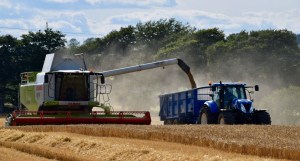
Combining at Kirkton, just north of Aberdeen, which is the main hub of the farming business.
The farm is split into three roughly similar sized holdings, with the main hub at Kirkton of Kinellar, just north of Aberdeen. Three miles down the road is Aquherton, while Floors is 23 miles further north at Auchterless – fortunately near his main employee Grant Cameron’s home, which helps with logistics in winter. Larger fields, which have much lower stone content than at the other two farms, helps cut labour costs and increase efficiency.
“One big advantage is we normally get all the spring barley cut at home before we travel up there to help spread risk and workload.”
A further 40ha is contract farmed at Auchnagatt, near Ellon. Winter wheat and oilseed rape make up around a third of his total cropped area. Around 22ha of green manure is grown as part of his existing AECS scheme – which is sown in May and mulched in August, making a good entry for wheat, while 10-20ha is rented out for potatoes.
Winter barley has been dropped in favour of winter oats which, with its later harvest, gives around three weeks longer to concentrate on the family’s other enterprise, an excavation business, at a peak time in the summer.
But spring barley is his main crop – around 200ha is grown each season for malting by Bairds Malt or Diageo – split between different varieties at each holding. That spreads risk, he says. Sassy was grown at Floors, Diablo at Kirkton and Aquherton, and Tungsten at Auchnagatt. “We’ve got storage buildings in each location so we can store separately.”
With the rising malting barley commodity market, he’s already traded some futures ranging from £216/t to £244/t, which is the highest price he’s ever sold malting barley for. “But you have to watch greed doesn’t kick in. It does feel wrong to profit when somebody else is having a terrible time in Ukraine, so I’m going to hold for the moment.
“Our costs are rocketing though, and we will need to feed the nation. I can see an upside to this market yet.”
Having bought nitrogen fertiliser before the price exploded in the autumn, stocked up on diesel for spring drilling and some of the chemicals for spring barley and OSR, this harvest should be profitable, he says.
“But my concern is harvest 2023,” he says, sighing. “Nitrogen is at £670/t, 16:16:16 at £680/t, fuel could be £1.10/L, although grains could be way up in price as well. It’s just so difficult doing a budget.”
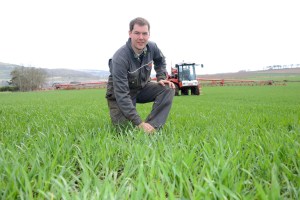
Scott Campbell is weighing up his options in the light of world events and the impact on both input and commodity prices.
He’s trying to minimise his risk and exposure to high fertiliser prices by purchasing anaerobic digestate from Sinclair Agricultural and Recycling Services in Ellon, alongside an existing ‘straw for muck’ deal.
“All our land at Kirkton and Aquherton gets muck or digestate at least once every four years. The green manure also saves us 20-25% on bagged fertiliser, and we’re trying some backend cover crops to keep the nutrients in the soil,” he explains.
These are grazed by sheep from local young farmers. Encouraging the next generation is important to Scott – he also hosts student visits, practical projects and trials from SRUC Craibstone.
On spring barley, the 105kg/ha of bought N is all applied by the time the crop is peeping through. “We do that to keep the nitrogen low for the malting market. We’re finding with these newer varieties, which tiller more, we can push them a bit harder to get more yield, and the nitrogen is still quite a bit below 1.65%, which 10 years ago you’d never have managed.”
That extra fertiliser can mean higher disease pressure, which he combats with a three-spray programme starting at GS30/31 rather than at T0. Early on, rhynchosporium and mildew are his main concerns, with the aim to keep as many tillers as possible viable and reduce stress to minimise ramularia risk.
He also uses that timing to control any weeds his pre-emergence spray has left behind, to adjust trace element requirements and to apply some growth regulator.
The flag leaf spray is used to control wild oats and also reduce the potential for brackling, as well as protecting against ramularia, while the ear spray at T3 is a bit of insurance, especially against skinning, he says.
In last season’s BASF Real Results trial in a crop of LG Diablo spring barley, the field treatment of Propel Xpro (bixafen+ prothioconazole) plus spiroxamine at T1, followed by Imtrex (fluxapyroxad) plus Phoenix (folpet) at T2, was compared with a BASF programme of Priaxor (fluxapyroxad+ pyraclostrobin) plus Decoy (pyraclostrobin), followed by Revystar (mefentrifluconazole+ fluxapyroxad) plus Phoenix. Both programmes had Decoy as a common T3.
The yield results showed over a 0.4t/ha advantage for the BASF programme, says Scottie Milne, a BASF agronomy manager for Scotland.
“Ramularia is a big concern in Scotland, and Revysol is now the best azole for reduction of ramularia,” he claims. “It delays the onset of the disease coming into the crop.
“By going in at T1 with pyraclostrobin and fluxapyroxad you’re also helping to reduce the stress on the crop, alongside getting the nutrition programme right through the tissue analysis Scott does.”
He also describes fluxapyroxad as the best SDHI active against rhynchosporium, while pyraclostrobin is strong against net blotch.
ADAS analysis of the results were not able to confirm whether the difference was due to the treatments or underlying variation, with little other differences being observed in disease control, specific weights or thousand grain weight.
The results have encouraged Scott to use a bit more Revystar this season. “We might not have got those results over the whole farm but, especially on the good bits, we’ll look to use it and push yield where we can,” he concludes.
Extra investment in fungicide pays dividends
A near 0.8t/ha improvement from the higher input ‘Farm Agronomy Max’ treatment in his KWS Lili Real Results trial means Scott will consider where using higher rates will pay. “I don’t think you could make the colour of it any better,” he says.
After a standard T0, each of the three following timings had either higher rates of Revystar, or additional pyraclostrobin on top of the standard Kestrel T3 treatment in the Agronomy Max treatment, explains Scottie.
The result was a 13.29t/ha yield compared with 12.51t/ha for his standard programme based on very similar actives at lower doses, and 12.79t/ha for the standard BASF programme.
ADAS analysis of the results concluded that while yield mapping data was not available from the trial, the size of the benefit from the Agronomy Max treatment gave confidence this was a real treatment difference. That conclusion was supported by a visible NDVI benefit from satellite imagery in late July.
“It cost an extra £52/ha in fungicide,” says Scott. “But taking that 0.78t/ha extra yield and my average selling price of £190/t, that’s worth an additional £96.20/ha in margin after taking off the fungicide costs.”
Some caution has to be applied to the results because it’s a tramline trial, he notes. “If you were treating the whole field, it’s worth using a management process so you only use the higher spend on the better bits of the field that you know are going to perform.”
That comes back to getting the foundations right, especially drainage, which is a speciality of his father and the excavation business, as well as maintaining correct soil pH and general soil health. “You probably wouldn’t want to be spending that if the pH was 5.5, or there was a burst drain in the middle of the field, or parts of the field are on the thin side,” he adds.
Fungicide spend in Scotland does tend to be higher than further south, while weed control costs are lower, says Scottie. “We’re under more disease pressure given the varieties that perform well up here. The saving on blackgrass probably goes on drying costs.”
The wheat varieties with excellent septoria resistance, such as KWS Extase, haven’t suited Scotland, so he grows Skyscraper, KWS Lili and Elicit, with a small area this year of RGT Saki. None of them have septoria resistance ratings much above a five on the SRUC Recommended List, which makes timing crucial in a climate that produces around 800mm of rain a year.
“It seems to be more extreme weather now. The crop can be looking clean and then there’s some rain splash and before you know it disease has come up the plant.
“That’s why we try to have a spray policy of every three weeks to try and keep it clean. Timing is as equally important as product. Last season timings were spot on, and we had super yields.”
The Real Results Circle
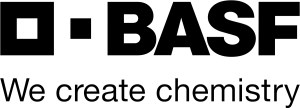
BASF’s Real Results Circle farmer-led trials are now in their sixth year. The initiative is focused on working with 50 farmers to conduct field-scale trials on their own farms using their own kit and management systems. The trials are all assessed using ADAS’ Agronomics tool which delivers statistical confidence to tramline, or field-wide treatment comparisons – an important part of Real Results.

In this series we follow the journey, thinking and results from farmers involved in the programme. The features also look at some in-depth related topics, such as SDHI performance and data capture and use.
We want farmers to share their knowledge and conduct on-farm trials. By coming together to face challenges as one, we can find out what really works and shape the future of UK agriculture.
To keep in touch with the progress of these growers and the trials, click here.
This article was taken from the latest issue of CPM. For more articles like this, subscribe here.

